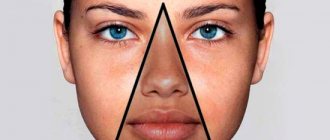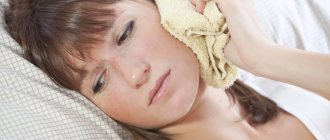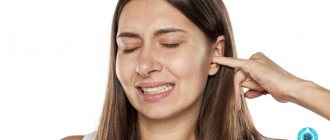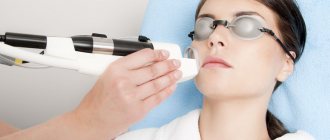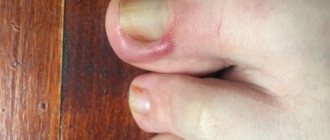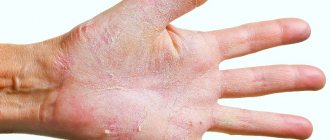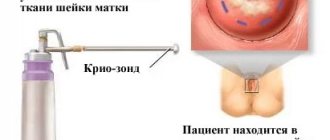Acne is a common problem. For some, their formation is of a single, periodic nature. Others suffer from a significant external defect. Both categories of “carriers” understand that the best means of combating are properly selected washing gels and lotions, proper nutrition, masks, lotions made from natural antiseptics, and so on.
But such knowledge does not prevent them from enjoying squeezing pimples. Is it possible to do this? What could be the consequences of this approach and why should you not squeeze out pimples?
Reasons for appearance
There are a variety of factors that cause skin pathologies on the face and body.
Among them:
- Adolescence. The fact is that it is during this period of life that hormonal levels are established, which is why inflammatory formations occur on the skin.
- Hyperkeratosis. As a result of intoxication of the body, vitamin deficiency or hormonal changes, a significant increase in the upper stratum corneum of the skin can occur.
- Menstruation. Immediately before menstruation, women experience a release of steroid hormones, which leads to skin problems.
- Use of low-quality cosmetics and cosmetics. Also, if you use cosmetics in large quantities and very often, this can lead to various rashes.
- Poor nutrition. Excessively fatty, fried and heavy food for the stomach can cause cosmetic problems.
- Hidden diseases of internal organs and the whole body.
- Stressful situations.
- Climate change. Sometimes banal changes in climate conditions contribute to the appearance of skin rashes.
Is it possible to squeeze out blackheads?
Comedones are located deep in the pores, containing fatty deposits and dead epidermis. It is very difficult to squeeze out the entire blackhead, since only its upper part is visible. With partial elimination of comedones, inflammation begins and the situation worsens.
Dots should be squeezed out only in extreme cases, when they are very noticeable to others. If the rashes are small, it is better not to take risks and not touch them. Rough intervention can ruin the skin, lead to infections and other problems.
Incomplete extrusion of blackheads is fraught with complications. It is better to order services at a beauty salon to achieve maximum effect. If it is not possible to use the services of a cosmetologist, you need to approach the procedure correctly.
Doctors' opinion
And yet, experts do not recommend squeezing out pimples yourself at home. This process is very delicate, and if sterility rules are not followed, the extrusion procedure can lead to serious consequences. Doctors strongly do not recommend performing this procedure in person.
However, despite this, there is a type of skin formation that is quite safe to squeeze out, naturally, only if certain rules of this procedure are observed.
How to deal with acne correctly?
To combat the defect in question, cosmetologists and dermatologists advise adhering to the following recommendations:
- do not wash your face with hot water;
- do not use soap (it is necessary to replace it with special products);
- carry out contrast washes (alternate warm - cold - warm ... cold water);
- use scrubs (you can prepare them yourself);
- include antiseptic drugs in the list of daily used products (they can be natural);
- do not touch your face with dirty hands;
- do not squeeze pimples;
- stop drinking alcoholic beverages;
- use special protective creams during hot and cold hikes;
- minimize the consumption of fried and salty foods, smoked meats, mayonnaise, carbonated drinks, sweets;
- drink enough liquid (preferably clean water);
- include fresh vegetables and fruits in your diet;
- overcome nicotine addiction.
However, there are cases when following these recommendations is not able to provide the desired result and you cannot do without medical help.
Why you shouldn't squeeze pimples on your face
There are serious health risks associated with self-pimple removal. So, why shouldn’t you squeeze out inflamed purulent formations?
Appearance of scars
When mechanical pressure is applied to the skin layer, damage occurs, which can result in scars and rough scars.
These consequences are not easy to treat. Scars also worsen a person’s appearance and contribute to the development of complexes. This factor especially affects the female half of the population.
Blood poisoning
Another frightening consequence of squeezing out even seemingly harmless pimples is blood poisoning. The main reason for this is the unsterile conditions of the procedure and non-compliance with certain rules.
The fact is that the purulent contents of a pimple can be squeezed out both outward and inward, which will lead to infectious blood lesions.
Also, the infection can get through an unhealed pimple wound, which will lead to certain complications. It is especially dangerous to do such procedures in the areas of the nasolabial triangle and on the nose.
It is here that many vessels are located that supply the brain with blood. If the infection penetrates these areas, there is a high probability of developing meningitis.
Cosmetological defect
Removing acne causes bumps and unevenness to appear on the skin. It is worth noting that these defects do not fall into the category of health hazards, but they greatly spoil the appearance and cause a lot of aesthetic inconvenience.
If we take into account the existing consequences of squeezing out acne vulgaris, the answer to the question becomes clear whether it is possible to remove inflammatory tumors on your own.
Consequences of squeezing pimples
First of all, this is the formation of small scars. Extrusion entails deformation of the skin, as a result of which the restorative functions of the epidermis become weaker.
If the root has not been removed, there is a risk of remaining with a scar forever, which can only be corrected with laser correction.
Secondly, it is an infection. After a successfully performed squeezing procedure, a wound remains on the top layer of the skin, into which harmful microorganisms can easily penetrate, which leads to infection. Due to the walls of blood vessels and capillaries damaged by bacteria, blood flow begins, which cannot be stopped, and as a result - blood poisoning.
Redness. This consequence can be called the most harmless, since it is masked with ordinary powder.
Which ones can be pressed?
To decide which pimples can be squeezed out and which ones should not be squeezed out, it is necessary to classify the type of formation that has arisen.
According to their structure, skin rashes can be divided into inflammatory and those in which inflammatory processes are completely absent.
The first type of skin formations can be distinguished by:
- changes in skin color (redness);
- swelling may occur;
- the formation rises above the surface of the epidermis;
- viewing purulent contents;
- painful sensations when pressed.
Formations in which inflammatory processes do not occur look like small bulges. Such formations are called comedones, and they arise due to blockage of the sebaceous glands.
In turn, comedones are divided into several types:
- Open. The size of the rash does not exceed a couple of millimeters and looks like black dots on the skin. The saturation of the dark shade indicates the age of the neoplasm. Initially, the clogged sebaceous plug has a light shade; over time, it oxidizes in air, which leads to its darkening.
If you do not neglect special conditions and rules, comedones can be squeezed out yourself. If you ignore these norms, the squeezed comedon can become infected.
- Milia or closed comedones. They arise due to blockage of pores, but from the lower part. Outwardly they are hardly noticeable, but upon palpation they are clearly palpable. If there is a large accumulation of comedones on the face, the skin takes on a rough appearance and becomes like sandpaper.
It is worth noting that such formations should not be removed under any circumstances. The fact is that milia can unite with each other and form extensive subcutaneous channels. If removed incorrectly, these canals can fill with pus, which can lead to serious consequences. Only an experienced professional in a sterile clinical environment can perform facial cleansing safely.
- Pustules. Small tubercles in which purulent contents are visible through a thin layer of skin. At the top of the formation there is always a whitish dot, with inflamed skin around it. In some cases, pustules can be squeezed out on their own.
- Papules. When an infection penetrates the comedone, a papule appears. These formations can reach 1 cm in diameter and look like burgundy or red bumps. If you try to squeeze out the papule, especially at home, this will worsen the clinical picture.
So, from the above it follows that you can only squeeze certain pimples, subject to certain rules:
- small pustules can be removed;
- pimples that are deeply yellow or green should not be touched;
- You can squeeze the pus out only when the redness of the pimple subsides.
Read what conglobate globular acne is. Steroid acne on the face, look at the photo, here.
If there are many of them
It is the number of pimples that is a significant factor in the safety of squeezing them out.
Acne varies in severity according to its severity:
- light;
- moderate;
- heavy;
- launched.
In the first case, the formations can be removed independently, but only if certain rules are followed.
The moderate form implies the presence of a purulent formation. If the total number of inflamed formations does not exceed 10, they can be squeezed out, but together with additional treatment.
A severe and advanced form of the rash on the face is caused by the presence of large formations, the number of which exceeds 25 pieces. Squeezing such pimples is strictly prohibited, as this can lead to blood poisoning and meningitis.
Regarding the advanced form, in this case the purulent contents can infect healthy areas of the skin if it is removed out through mechanical damage to the epidermis.
What to do if a pimple appears?
Getting rid of acne by squeezing is allowed, but subject to strict adherence to certain conditions, if this pimple is a single one. If you are sure that a couple of pimples popped up on your own, they are not associated with internal problems of the body, let's try to remove acne. Instructions on how to squeeze out a pimple:
- Touch the inner pimple. If it is painless, the inflammatory process of the pimple is over, it is ready to be expelled. In this case, the pimple has a formed, slightly dried head.
- Wash your hands. Carefully, with soap, you can use an antiseptic.
- Arm yourself with chlorhexidine. Disinfectant, the main enemy of bacteria that cause acne. Treat the area around the pimple with chlorhexidine.
- Protect your hands. Even though your hands are washed, you should protect yourself from the recurrence of acne. To do this, wear medical gloves or wrap your fingers in a clean cloth.
- Squeeze it out. Comedones (black or white spots on the skin) are easier to remove. Lightly press the skin next to the pimple and the contents of the contaminated pore will come out.
- Let's press. For the event to be successful, squeeze out the pore completely until a drop of blood appears.
- Blood. As soon as you see blood, immediately stop pressing on the skin! Everything has been done correctly. If you continue to press on this place after the appearance of a bloody drop, in 99% of cases you will get a bluish spot.
After removing the pimple, treat the red spot on the wound so that it does not swell. Use alcohol: moisten a cotton pad with it and gently wipe the affected area. You will feel a burning sensation - this is normal. Instead of alcohol, salicylic acid is suitable - in this case, it is important not to overuse the cotton wool, otherwise you can burn the skin. Soon, in place of the former pimple, a small lump with a crust will form - you cannot rip it off! It will disappear on its own after 1-2 days.
Attention! If, wanting to get rid of a pimple and pressing on it, you feel pain - give up your idea! The “favorite” eel is not yet ripe for destruction, your efforts are fraught with consequences.
First aid kit against pimples
Your home medicine cabinet must contain preventative facial care products. Prevention is important - all people without exception experience acne. It's better to prevent than to fight. Arm yourself with:
- Salicylic acid. Anti-inflammatory, antibacterial substance. Salicylic acid dries out pimples - apply it pointwise to individual acne. The use of salicylic acid will prevent the appearance of post-acne (spots after acne has healed). For your home first aid kit, stock up on a 1-2% solution of salicylic acid.
- Tar soap. Although unattractive on the outside, this soap is the best in germicidal action. The drying and exfoliating properties of tar soap will help fight harmful microflora. But this soap is not suitable for people whose skin is sensitive and prone to allergies.
- Bactericidal agents (Clerasil, Dalatsin, Zinerit, Baziron). These substances contain a complex of disinfecting, drying, and antimicrobial components. Use them to treat skin in advanced conditions.
It is forbidden! Conceal pimples with cosmetics (foundation, powder, concealers, correctors). The smallest particles of cosmetics can tightly clog already inflamed pores. Instead of clear skin, you will get a lot of new problems in the form of acne spreading to other areas of the face.
Can! And you need to use traditional medicine recipes. Natural, environmentally friendly folk remedies proven over centuries. Their use will not cause adverse reactions, but will only provide benefits.
A series. Thanks to its regenerating and antibacterial properties, the medicinal herb perfectly cleanses the skin with shine and cleanses the blood.
- For external use, prepare an infusion of the plant: 1.5 tbsp. Pour boiling water (1.5 cups) over the herbs. Leave for half an hour, filter. Moisten a clean bandage or gauze with the broth and apply to the affected areas for 30-40 minutes. Repeat the procedure 2-3 times daily.
- To take the healing infusion internally, steam the herb (1 tsp) with a glass of boiling water. Drink 1/2 glass of tincture three times a day half an hour before meals. The course of treatment is 1-1.5 months.
Anti-acne masks. They will help deal with problem skin, which “pleases” owners with inflammatory rashes.
- Mix fresh egg white with vodka (100 g), add iodine (1-2 drops). Apply the mixture to your face and leave for a quarter of an hour. This product heals wounds, cleanses, and disinfects the epidermis.
- Apply whipped egg white to your face and leave until completely dry. Lecithin, which is part of the protein composition, restores the skin and dries out oily skin.
- Brew green tea and let it sit for 5-10 minutes. Moisten a gauze with aromatic liquid and apply it to your face. Periodically wet the cloth with warm tea. This procedure soothes inflamed skin and neutralizes harmful bacteria.
- Apply liquid honey to your cleansed face and leave for 10-15 minutes. Honey is an anti-inflammatory and antibacterial agent. But be careful with it - the honey substance can cause skin allergies.
Products for cleansing inflamed skin. You should wipe your face with prepared natural tonics 2-3 times daily.
- Cut 2-3 Aloe leaves from a plant older than 3 years. Keep the leaves in the cold for 3-4 days and chop. Then squeeze the juice out of the mass. Aloe juice draws out the purulent contents of the pores and disinfects them.
- Steam calendula flowers (1 tbsp) with boiling water (1.2 l), leave for half an hour, filter. Calendula has disinfectant and antiseptic properties.
- Dilute baking soda to a paste. It should be applied pointwise to the pimple itself. Baking soda dries the skin, reduces oiliness, tightens pores, and prevents the spread of acne.
It is important not to clog the body from the inside by adhering to a healthy diet. Healthy food consists of foods with a high content of vitamins B, A, C (vegetables, herbs, fruits, lean meat, liver). Eat egg yolks! They are good for the skin. But “snacks” in the form of chips, kirieshki, sweets, fast food, smoked meats are classified as “junk” food. Such food pollutes the body, helping acne develop.
Important! To make your facial skin glowing, clean, and elastic, include brewer’s yeast and bran in your diet. They can be purchased at the pharmacy. Nuts, sunflower seeds, soybeans, and seafood are good for the health of the epidermis.
How a cosmetologist can help
When treating extensive acne, contacting a professional cosmetologist is an important point to completely get rid of inflammation. With the help of hardware cosmetology, manual or chemical therapy, acne, even in the active phase, is quickly relieved.
Face cleaning . The first stage in the battle against acne. The procedure will help clean clogged pores, empty pustules, and remove acne. The cosmetologist, based on the degree of inflammation, will offer you one of the following procedures:
- Mechanical cleaning. A painful procedure, especially in advanced conditions. But it is necessary to completely eliminate all obstacles on the path to healthy skin. Using a special spoon or manually, the specialist releases pus and draws out impurities. At the end of the session, the face may be inflamed and painful for some time - this is a normal reaction of the body.
- Ultrasonic cleaning. The least gentle procedure, in which the dermis is cleaned with special tools. But this way is less effective - it is prescribed for easily contaminated areas of the skin.
- Cleaning with fruit acids. Using individually selected acids, the top layer of the epidermis is removed along with excess sebum. Peeling improves the condition of the skin, triggers the independent synthesis of collagen fibers, which heals and rejuvenates the dermis.
Cosmetology procedures are carried out in courses. How long your face will need to be treated depends on the condition of the skin and individual characteristics. Between sessions, it is forbidden to bask in the sun, swim, or use irritating cosmetics. Therefore, it is better to conduct treatment courses in the autumn-winter period.
Attention! Before going for treatment, make inquiries about the salon. The work of a non-professional can only aggravate the situation and cause a serious infection under the skin. It is not recommended to do professional facials yourself - you can seriously harm your skin.
Expert advice
So, if you decide to squeeze out the formation on your face, you should follow the advice of medical experts:
- it is necessary to pre-steam the skin if there is a need to squeeze out the comedone;
- it will be easy to open the pustule if you apply ichthyol ointment to the skin at night;
- Before the removal procedure, you need to thoroughly wash your hands and face with soap;
- wrap your index fingers with a sterile bandage (thin layer);
- first wipe the acne with an alcohol solution to remove bacteria from the skin;
- you need to press your fingers directly on the root of the eel, and not on its surface;
- after removing its contents, rinse the wound with hydrogen peroxide;
- For a couple of days, refrain from applying powder and other cosmetics to your face.
First aid rules for pimples
If a subcutaneous abscess is detected, the best solution is to leave it alone - within 2-3 days a dry crust will form in its place, which will fall off on its own, and the small wound will heal.
To speed up this process and protect yourself from harmful bacteria, you should dry the pimple with antibacterial and antiseptic agents:
- 1% Salicylic Acid is a gentle exfoliant that promotes rapid healing and prevents the formation of dark spots. Should be applied pointwise 1-2 times a day.
- Tea tree oil is an express remedy that acts instantly.
- Tar soap - for extensive lesions, it is recommended to disinfect the wounds with a soap solution before applying spot treatments.
- Pharmacy products with complex action - Zinerit, Klerasil, Levomycetin, Zerkalin and others are prescribed in advanced cases.
Important! Do not overuse alcohol lotions - dry pores will have the opposite effect and cause irritation.
If necessary, you can remove superficial single pimples, which do not cause pain with light pressure. This means that the inflammatory process has ended and the risk of infection has decreased.
Procedure for safe acne removal:
- Hands should be disinfected with an antiseptic, and fingers should be wrapped in a napkin.
- The skin around the acne should be treated with chlorhexidine.
- You cannot press directly on the pimple - then its contents will get inside; you need to press with your fingertips on the area around the lesion.
- If drops of blood appear, the procedure should be stopped.
- Finally, the wound is treated with salicylic acid.
- For 1-2 days, a crust will form at the site of cleaning, which will eventually fall off on its own.
How to calm your face?
Naturally, after the extrusion procedure, the surface layer of the skin is damaged and acquires a red tint. There are products that can help soothe your facial skin.
Masks
Applying a soothing mask to your face can soothe irritated skin.
For this it is good to use:
- light clay;
- fresh cucumber masks;
- a mixture of calendula and honey 1:1;
- from aloe leaves and so on.
Lotions
After removing acne, you can soothe the skin with medical lotions for wiping the skin of the face. They have an antiseptic and calming effect.
You can also make your own lotion. To do this you will need chamomile color (1 tablespoon) and 500 ml of water. Bring the broth to a boil and let it brew for a couple of hours.
Crema
Antiseptic ointments and creams also help heal damaged epidermis. Typically, these drugs for external use are prescribed by a doctor, based on the nature of the skin pathology and skin type.
Preparing for facial cleansing
Cleaning by a cosmetologist assumes that the skin will be prepared for the procedure. During the week before visiting the salon, experts recommend thoroughly moisturizing your face. To do this, use a non-comedogenic cream. Also during this time it is necessary to wipe your face with salicylic alcohol once a day. This will remove existing inflammation and prevent the appearance of new acne.
Cleaning is contraindicated if a person suffers from rosacea, eczema, allergic dermatitis, or herpes. And also in the presence of large red inflammations. During your consultation, a cosmetologist can also tell you why you should not squeeze pimples on your chest.
Photos before and after
See methods for cleaning your face from acne at home. How to get rid of the causes of whiteheads on the face. Find out further.
How to choose an effective treatment with tablets for juvenile acne with pustules?
The answer is here. Well, for sure, many are convinced that acne on the face is more than a serious problem. There are serious risks of self-squeezing formations, and this must be remembered. At the first symptoms of acne formation, you should seek medical help.
Alternative Methods
Having found out why you can’t squeeze acne on your face, you can solve this issue by turning to cosmetology. There are a number of deep cleansing procedures, during which the contents of acne and blackheads are removed without harming the epidermis.
However, they have contraindications and are selected individually depending on the problem of concern. Also, in almost all cases, a temporary period of rehabilitation is required, during which it is forbidden to appear in the open sun and apply decorative cosmetics.
Mechanical cleaning
For those who are wondering whether it is possible to squeeze out acne without serious consequences, this procedure is suitable. Cleaning with special tools by a highly qualified cosmetologist is the correct removal of lesions.
Peculiarities:
- Indicated for people with acne, blackheads on the nose and chin, fatty spots not only in the facial area, but also on other parts of the body (chest, shoulders, back).
- Working tool – Unna spoon. Made as a metal stick with two ends. One has a curved spatula with a hole through which the contents of the pimple come out. The other is represented by a sieve designed to remove excess fat and dead particles of dermis.
- The procedure is carried out in compliance with all sanitary standards using disinfected equipment.
- Side effects include pain, rosacea, bruises, and crusts at the treatment sites. Therefore, a rehabilitation period is required to restore the structures of the epidermis.
- It is recommended to use once a month for those with normal to oily skin. No more than once every six months on dry surfaces.
Vacuum cleaning
This method is considered safer; a special device is used for cleaning. This factor is very important, since there is no contact between the skin of the face and the hands of the master, which guarantees the avoidance of infection. However, if the pimple is not mature enough and it is not possible to pull it out with a vacuum, the cosmetologist can remove it himself.
Peculiarities:
- suitable for those with oily skin clogged with sebaceous plugs and acne; can remove white pimples and open pustular rashes;
- drawing out impurities, does not damage the structure of the sebaceous glands; used in hard-to-reach places (in the wings of the nose, ears);
- does not cause discomfort or pain; there is virtually no discomfort during the procedure;
- It is recommended to carry out such a deep cleansing approximately once a month.
Ultrasonic cleaning
It takes place in two stages. First, with the help of cosmetic acidic products, they act on the structure of the pimple, destroying it, and then cleanse the skin with high-frequency vibrations.
Peculiarities:
- It is effective only against superficial rashes; it will not work on large and deep pimples.
- Suitable for people with dull and oily skin, enlarged pores.
- Can be performed in sensitive areas - on the lips and neck.
- It is considered the most delicate and safe type of cleaning.
- Improves blood circulation, softens tissues, making the dermis more receptive to other cosmetics and care procedures.
- If the problem cannot be eliminated immediately, a course of such procedures is required at intervals of one and a half months.
Chemical peeling
Based on the effect of acids on the skin. The applied drug removes the keratinized layer of cells, the dermis is renewed, and the fat balance returns to normal.
Peculiarities:
- Removes acne, inflammation, post-acne spots.
- Evens out the relief of acne-damaged skin, heals scars and scars.
- Depending on the severity of the acne, a product is selected according to the degree of impact on the skin (superficial or deeper).
- There are different types of drugs, it is possible to choose the one that is suitable for a specific problem.
- Superficial or medium peeling has a recovery period of several days to a week.
- After deep cleaning, complete regeneration of the integument occurs within a month.
Those who are still hesitant about popping pimples on their face are likely to face not only aesthetic problems, but also more serious medical damage. Therefore, it is worth abandoning this technique and directing all efforts to eradicate this dangerous habit. Proper skin care and periodic cleansing in a specialized beauty salon will give it a healthy and fresh look.
Features of squeezing out blackheads on the nose and possible manipulation options
Doctors and cosmetologists do not recommend removing blockages using a mechanical method: it is easy to damage the skin and cause an infection, causing it to spread quickly due to the abundant blood flow. You can squeeze out blackheads on your nose yourself; there is a risk of scarring; manipulation in the area of the wings causes severe pain.
There are no absolute contraindications to the procedure; following the recommendations for preparing your face, you will be able to carefully and safely clean the surface.
Options for manipulation to get rid of acne:
- Squeeze out blackheads on the nose with the tip of a pen. The attribute is disinfected in an alcohol solution, and the face is steamed before cleaning. The device is placed over the pimple with the tip facing away from you, applied to the epidermis, and pressed with your fingers on the column (the principle of operation of a pipette). A vacuum is created, the head of the comedone is pulled out of the pore. After the procedure, wipe the face with a soothing lotion.
- Getting rid of formations using matches aimed at each other. The action is local and does not injure the epidermis.
- Squeezing out black elements with floss (dental floss is possible). A 10-20 centimeter sewing accessory is pulled between the fingers and passed along the nose from base to tip. The dot heads will come out as the attribute is promoted.
- Using soda. To effectively cleanse the pores on the nose, use a food additive; before applying the composition, the skin is steamed and the problem area is treated with massaging movements. After cleansing, wash off the substance with water. Dirt is removed and the skin whitens.
